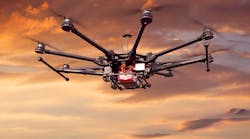Unmanned aircraft systems (UASs) have become a component of modern warfare, for better or worse. Because commercial drones are readily available and capable of being weaponized for potential terrorist use, defense strategies are needed to combat the use of commercial UAS platforms for such intentions. In league with this strategy, the U.S. Marine Corps Warfighting Lab, in partnership with Defense Innovation Unit Experimental (DIUx), has awarded a contract to Sensofusion in support of the company’s AIRFENCE Mobile countermeasures system to fight the use of drones for terrorist activities.
AIRFENCE Mobile is a countermeasure technology designed to automatically detect, locate, track, and assume control of a UAS within its RF detection range. It also has the capability to receive transmissions from a UAS operator’s transmitter, and apply direction-finding (DF) techniques to locate the source of the transmissions and the UAS operator.
The AIRFENCE system leverages software-defined-radio (SDR) technology. It combines signal detection and identification electronic hardware with signal-processing software capable of acting upon new intelligence. By storing signal intelligence and developing a database of threat signals, each system can more quickly recognize repeat offenders. The latest version of the AIRFENCE Mobile system is 4.0. It has been widely used by different governments and law enforcement agencies for detection and protection in such environments as airports, military bases, and government facilities.
Sensofusion currently partners with the U.S. Marine Corps, NATO, the FAA, the Nevada Institute of Autonomous Systems, and NASA UTM. Sensofusion’s technology is being integrated as the core of MCWL’s Mobile Counter-UAS system, enabling the Marines to experiment with this emerging capability while developing new tactics, techniques, and procedures.
“Given the proliferation of commercially available UASs and the increasingly dangerous threat they pose, a force protection capability like that provided by AIRFENCE will be an essential part of any integrated air defense system for the foreseeable future,” noted Major J.B. Persons of the Marine Corps Warfighting Laboratory. “We are eager to get this capability into experimentation and transition it to the operating forces as quickly as possible.”
Sensofusion plans to bring its technology to the U.S. Army, Navy, and Air Force, as well as the Department of Homeland Security, specifically for border protection.

